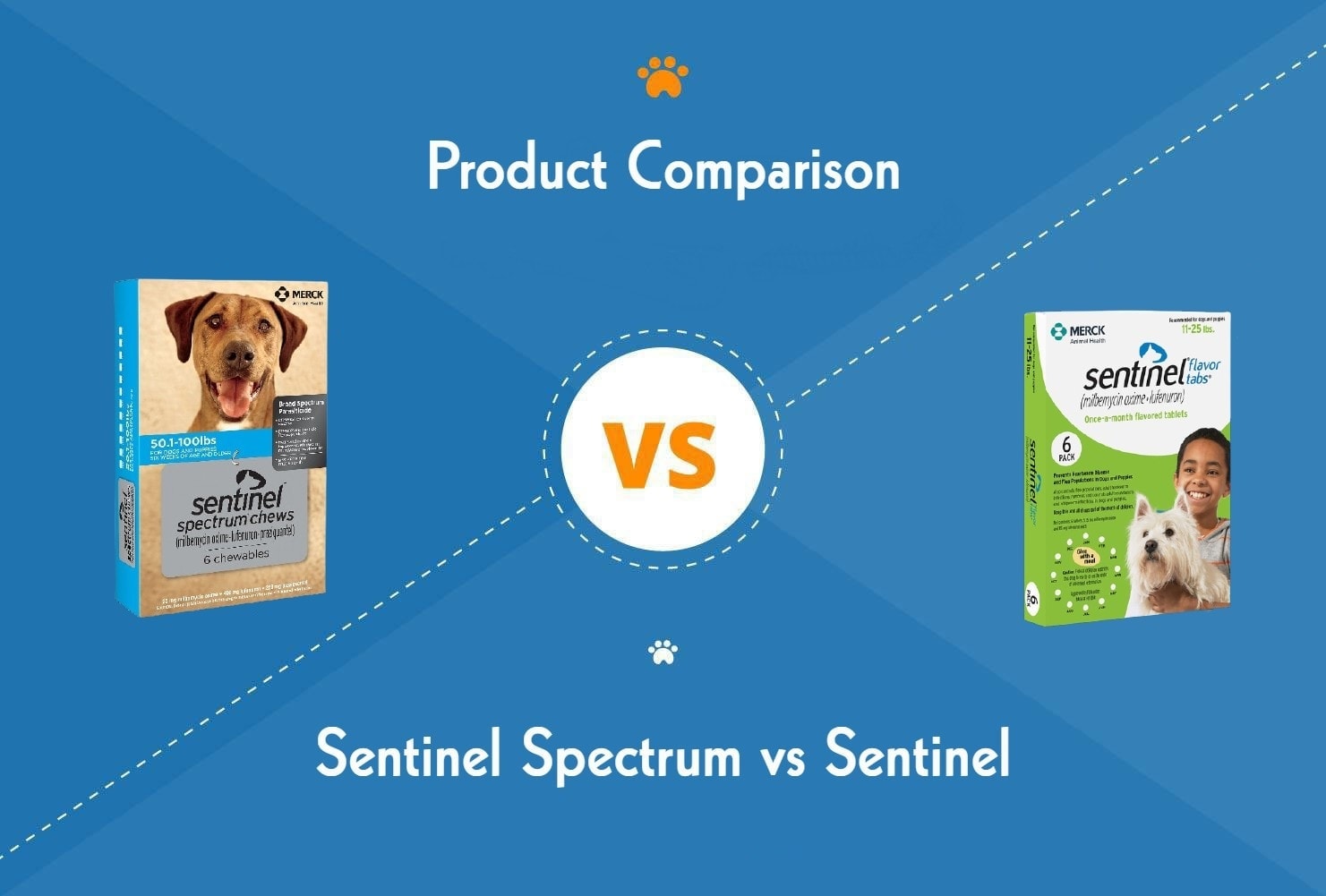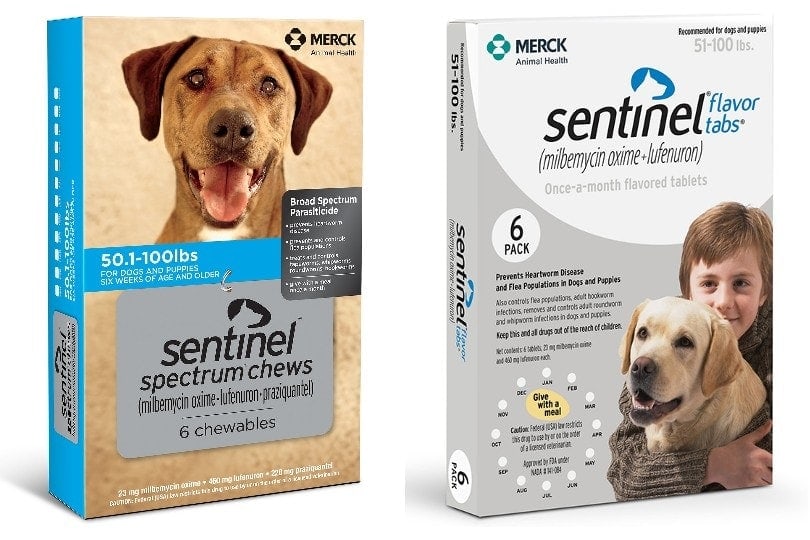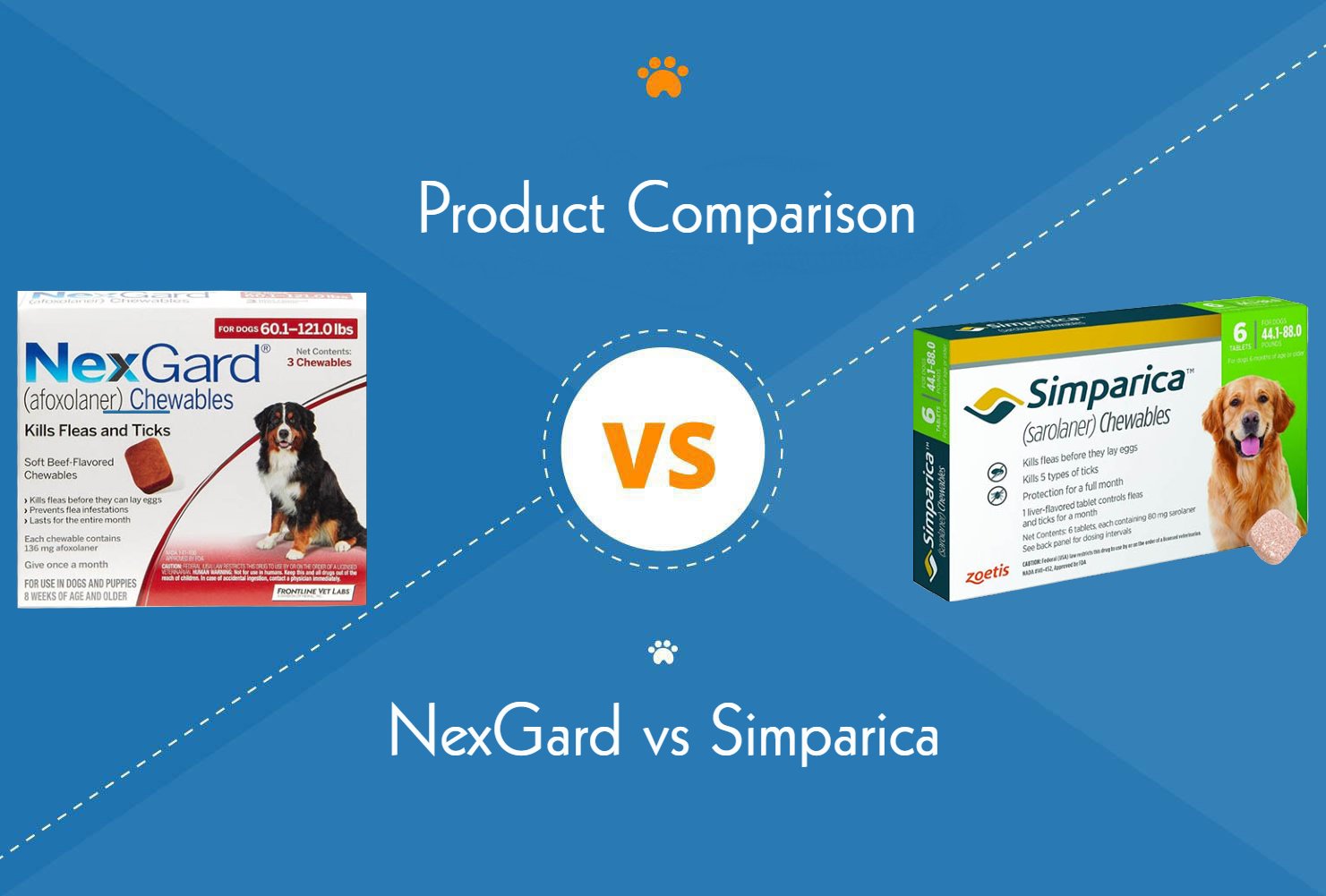Sentinel Spectrum vs Sentinel: Key Differences (Vet Answer)

By Dr. Rebecca MacMillan, BVetMed MRCVS (Vet)
Updated on

With so many treatments on the market, it can be tricky to know which parasite product to choose for our pets. Even more so when existing brands release a new version of an existing product but continue to sell the original. Should you automatically go for the latest one, in this case, Sentinel spectrum? Or should you stick to the tried and trusted original Sentinel? In this review, we will compare the differences between the two so that you can make an informed decision.
Both products are flavored tablets though Sentinel Spectrum is a chewable one which might make it more appealing for some dogs. They can both be hidden in food though which might be helpful.
Both Sentinel Spectrum and Sentinel are effective against immature fleas, heartworm, hookworm, roundworm, and whipworm, but Sentinel Spectrum also protects against tapeworm species. This makes it a more comprehensive form of parasite treatment, saving on the administration of additional deworming products.
If you have a very young or small animal requiring treatment, then you will need to choose Sentinel as this can be safely used in puppies as young as 4 weeks and 2lbs in bodyweight. Sentinel also has safety data for use in breeding females.
Both products will require a prescription from a veterinarian so if you are unsure which product is best for your pet then you can discuss it with them. Ultimately, the decision may be made by which product your veterinarian prefers and stocks in their clinic though!
At A Glance

- Milbemycin oxime, lufenuron and praziquantel
- Licensed for use in dogs
- Treats immature fleas, heartworm, adult hookworm, adult roundworm, adult tapeworm, and whipworm
- Given monthly
- Must be prescribed by a veterinarian
- Chewable flavored tablet
- Can be used in puppies 6 weeks and over
- Discuss its use in breeding bitches with your veterinarian
- Available in different tablet sizes for different body weights
- Milbemycin oxime and lufenuron
- Licensed for use in dogs
- Treats immature fleas, heartworm, hookworms, roundworms, and whipworms
- Given monthly
- Must be prescribed by a veterinarian
- Flavored tablets
- Can be used in puppies 4 weeks and over
- Safe to use at recommended doses in pregnant and nursing bitches
- Available in different tablet sizes for different body weights
Overview of Sentinel Spectrum

Ingredients
Sentinel Spectrum contains milbemycin oxime, praziquantel and lufenuron. Each chewable flavored tablet is formulated to provide a minimum dosage of 0.23 mg/lb (0.5 mg/kg) milbemycin oxime, 4.55 mg/lb (10 mg/kg) lufenuron, and 2.28 mg/lb (5 mg/kg) praziquantel.
Indications
Sentinel Spectrum is used to prevent heartworm disease (Dirofilaria immitis). This product helps prevent flea infestations by affecting the immature stages of the flea life cycle. Sentinel Spectrum also helps to both treat and control adult hookworm, (Ancylostoma caninum), adult roundworm (Toxocara canis and Toxascaris leonina), adult tapeworm (Taenia pisiformis, Echinococcus multilocularis and Echinococcus granulosus), and adult whipworm (Trichuris vulpis).
Dogs should be tested for the presence of heartworm before first starting treatment with this product, as this product is not suitable for use against adult heartworm and an alternative product may be required.
Instructions for use
Sentinel Spectrum can be used in dogs and puppies 6 weeks of age and over, and that weigh at least 2lb in weight.
Dosage
The tablets are given once a month by mouth and can be broken up for administration. It can be given by hand or with food. Ideally, administer around a normal mealtime to ensure maximum absorption of the product Make sure the appropriate tablet size is used for your dog’s body weight.
The product can be given all year round at continuous monthly intervals to provide maximum protection.
Mechanism of action
Sentinel Spectrum contains three active ingredients: milbemycin oxime, lufenuron, and praziquantel.
Milbemycin oxime affects the nerve and muscle cells causing the paralysis and death of parasites. It is particularly effective against the tissue stage of heartworm larvae, and the adult stage of hookworm, roundworm, and whipworm infestations.
Lufenuron breaks the flea life cycle by affecting the development of the flea eggs. It does not affect adult fleas themselves. A flea bites the dog ingesting blood containing lufenuron which is then deposited in her eggs. This stops the flea eggs from hatching into adults, helping to break their life cycle.
A concurrent adulticide product may be required to reduce the number of fleas more quickly, especially if there is a large flea infestation. Otherwise, it could take several weeks to see a noticeable drop in flea levels.
The exact mechanism of action of the final ingredient, praziquantel, is unknown. It is an effective dewormer, however, especially against various species of tapeworm.
Contraindications
There are no known contraindications to Sentinel Spectrum, though caution should be taken in breeding or lactating bitches, so discuss this with your veterinarian. The safety of Sentinel Spectrum has not been evaluated in these animals. Studies have only been performed with milbemycin oxime and lufenuron alone. As per the instructions, don’t use in puppies less than 6 weeks of age or in dogs with pre-existing heartworm infections.
Palatability
Sentinel Spectrum is a flavored chewable tablet. In a field study of 117 dogs offered this medication, 113 dogs (96.6%) accepted the product when offered from the hand as if a treat, 2 dogs (1.7%) accepted it from the bowl with food, 1 dog (0.9%) accepted it when it was placed in the dog’s mouth, and 1 dog (0.9%) refused it. This indicates that Sentinel Spectrum is tasty, and most dogs will accept it.
- A prescription drug, which means that you’re likely to get an effective product and your pet will be regularly examined by a veterinarian and any health problems will be picked up quicker
- Treats for multiple parasites including tapeworm
- A palatable chewable tablet which may make it more easily accepted by some dogs
- Can be taken by puppies as young as 6 weeks
- Doesn’t kill adult fleas, only the immature stages of the flea life cycle. A separate adulticide flea product may be required to reduce flea numbers more rapidly if there is an infestation
- Caution in breeding bitches advised, as safety has not been established
Overview of Sentinel

Ingredients
Sentinel contains milbemycin oxime and lufenuron. Each tablet is formulated to provide a minimum of 0.23 mg/pound (0.5 mg/kg) of milbemycin oxime and 4.55 mg/pound (10 mg/kg) body weight of lufenuron.
Indications
Milbemycin oxime is a type of parasiticide called a macrocyclic lactone, whilst lufenuron works as a flea contraceptive. Sentinel is therefore indicated for the prevention of heartworm disease (Dirofilaria immitis), for the prevention and control of flea populations, and the control of adult hookworms (Ancylostoma caninum), roundworm (Toxocara canis and Toxocara leonina), and whipworm (Trichuris vulpis).
According to Sentinel’s product information, dogs should be tested for the presence of heartworm before first treatment with this product as an alternative product may be required to kill adult heartworm and microfilariae.
Instructions for use
Sentinel can be used in dogs and puppies 4 weeks of age or older and weighing 2lbs or more in weight.
Dosage
The tablets are given once a month by month and must be given with or shortly after food to ensure effective absorption of the active ingredients. Make sure the appropriate tablet size is used for your dog’s body weight and that the entire tablet is eaten. You should never try to split tablets in half to give to a smaller dog than the tablet is designed for, as the drug may not be evenly distributed in the tablet.
The product can be given all year round at continuous monthly intervals to provide maximum protection.
Mechanism of action
The two ingredients in Sentinel serve different purposes.
Milbemycin oxime is a macrocyclic anthelmintic that interferes with invertebrate neurotransmission. This eliminates the tissue stage of heartworm larvae, and the adult stage of hookworm, roundworm, and whipworm infestations.
Lufenuron is an insect development inhibitor that breaks the flea life cycle by affecting the development of the flea eggs. It does not affect adult fleas. A separate adulticide product may be required to reduce the number of fleas more rapidly, especially if there is a large flea infestation. Otherwise, it could take several weeks to see a noticeable drop in flea levels with this product alone.
Contraindications
There are no real contraindications noted with Sentinel, other than not to use in puppies less than 4 weeks of age or in dogs that have pre-existing heartworm infections. The product appears to be safe at normal doses for pregnant and nursing bitches.
Palatability
Sentinel manufacturers claim the product is palatable, but no data was found to quantify this.
- A prescription product, meaning your pet will be regularly examined by a veterinarian meaning any health problems will be picked up on more quickly
- Can be used safely in very young puppies (4 weeks or older and weighing 2lb or more)
- Safety data is provided regarding use in pregnant bitches
- Breaks the flea life cycle by affecting egg development, meaning a separate adulticide product may be needed to reduce adult flea numbers more quickly
- Does not treat tapeworm species
- Not a chewable tablet and no palatability data, this may be an issue for some dogs
How do they compare?
Price range
Sentinel Spectrum may cost a bit more than Sentinel as it covers more parasites. Both are prescription tablet medications given monthly and will treat several parasites in one hit, so they may be more costly than some other more narrow-spectrum parasite products on the market.
Instructions for use
Sentinel can be used in very young puppies aged 4 weeks and up or 2lb bodyweight, whereas for Sentinel Spectrum they need to be 6 weeks and older (still 2lb bodyweight).

Mechanism of action
Both Sentinel and Sentinel Spectrum contain lufenuron which is an insect development inhibitor preventing the development of flea eggs. This is fine for routine prevention of flea infestations, but a product that kills adult fleas may be required if you have had a treatment lapse and flea numbers are out of control.
Sentinel Spectrum kills an additional parasite (tapeworm) compared to regular Sentinel due to the praziquantel it contains.
Tablet type
Sentinel Spectrum is a chewable flavored tablet whereas Sentinel is just a flavored tablet. Some dogs may prefer the soft, chewy consistency of Sentinel Spectrum.
Palatability
Both products claim to be palatable, but only Sentinel Spectrum provides data to back this up, with most doses being consumed straight from the hand like a treat.
Safety in breeding bitches
Sentinel Spectrum advises that safety hasn’t been established in breeding and lactating bitches, so you will need to discuss this with your veterinarian. Sentinel appears to be safe for use in pregnant and nursing bitches at the recommended dose.

What the users say
We have had a look at various pet-owning forums to see what users of these products had to say about them. Our research showed mixed reviews of both tablets, mainly based on the palatability and side effects of the medications.
Some users say that Sentinel Spectrum made their dog lethargic and go off their food. However other users of Sentinel Spectrum report no issues and say how effective the product is at parasite prevention.
Users of Sentinel say “it is very easy to administer it to my pet and from present and past use has been very effective”, and “our dog is fussy so I expected him to reject these tabs but he loved it”.
However, other users claim their dog wouldn’t take the tablets, so it is an individual thing.
Both products have been licensed for use so their effectiveness against their target parasites has been scientifically proven. Discuss with your veterinarian any concerns that you might have about medication side effects or palatability.
Conclusion
Sentinel and Sentinel Spectrum are broadly similar with the main difference being that the latter provides cover for tapeworm as well as the other parasites. Sentinel Spectrum also has data to back up its palatability claims so may be better for fussy dogs. However, if you need to treat very young puppies or breeding females then Sentinel is considered safer.
Both tablets will need to be given at the correct dose for your pet’s weight once a month, to ensure maximum effectiveness. Missing doses may leave your pet open to parasite infestations, so don’t take the risk!

















